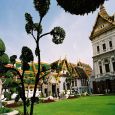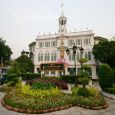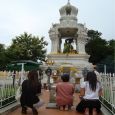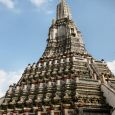Bangkok
Advertisement
By plane
Bangkok is served by two airports: Suvarnabhumi Airport and Don Muang Airport . Suvarnabhumi Airport is used by all airlines in Thailand, except for domestic flights on Nok Air and Orient Thai, which still use the old Don Muang Airport. Both these airports are about 30 kilometers (19 miles) from the city center, so be prepared for a long ride to get into the city. Also allow at least three hours to connect between them, as they are far away from each other and there is heavy congestion on the roads.
By bus
When buying tickets for buses out of Bangkok, it's best to skip travel agents and their private buses, and get the tickets for public buses directly at Bangkok's three public bus terminals. These buses are cheaper, safer, faster, more comfortable and won't scam you onto a clapped-out minibus halfway along the way or to a bedbug-infested hotel at the end. Each of these long haul bus terminals serve a different direction. They are purposefully located in off-central locations, so the long-haul buses avoid the heavy traffic congestion in the center of the city.
By train
The State Railway of Thailand serves Bangkok with railway lines from all four directions of Thailand. Hualamphong Train Station is the most important station, located close to Yaowarat and served by its own MRT station. It is a big and surprisingly convenient station built during the reign of King Rama VI. It spared bombing in World War II at the request of the Thai resistance movement.
By ship
Not many people come to Bangkok by boat, but there are some cruise ships that attend the city. Large ships must dock at Laem Chabang Port, about 90 minutes southeast of Bangkok and about 30 minutes north of Pattaya. A taxi service desk is available on the wharf, but charges extortionate prices for a trip to Bangkok — a whopping 2600 baht to charter a taxi (4 passengers), or about 5000 baht to charter a minibus (usually 11 passenger seats). Slightly lower prices can be found by walking out to the main road, about 4000 baht for a minibus, but even these rates are still almost double the typical rate in the opposite direction. Better deals may be possible for round trips .
By car
Getting into Bangkok by car is not a good idea, as you can easily waste half a day waiting in traffic just to get to the other side of the city. Three major highways lead to Bangkok from all directions of Thailand. The best way to get to Bangkok from Northern Thailand is driving on Phahonyothin Road (Route 1), which comes from Mae Sai near the Myanmarese border. Sukhumvit Road (Route 3) comes from cities in Eastern Thailand, such as Trat, Pattaya and Chonburi. Phetkasem Road (Route 4) must be one of the longest roads in the world, as it comes all the way from the Malaysian border serving Southern Thailand.
Grand Palace
Bangkok's most popular tourist attraction, the Grand Palace is the former residence of the King and is built adjacent to, and more or less integrated with Wat Phra Kaew (also known as the Temple of the Emerald Buddha). The palace was originally built together with the establishment of Bangkok by King Rama I and has been expanded ever since. It covers a wide range of architectural styles, ranging from a pure Ayutthayan style of the temples to a blend of Thai and Western for later structures. While the king no longer lives here, a large part of the complex is used for royal residences and ceremonies and is off-limits to tourists
Combined entry is a steep 350 baht, plus an optional 200 baht for a two-hour audio guide; Thais get in for free. Your ticket includes entry into the Dusit Palace in Dusit (valid for seven days). The Grand Palace is open every day from 8:30AM to 4:30PM, with the last tickets sold at 3:30PM; it cannot be said enough, do not believe any scammers who attempt to convince you otherwise. It is best to attend the Grand Palace during weekdays, as some throne halls are closed in the weekends for ceremonial purposes. Be aware that a strict dress code applies for visitors to the palace. Ladies must cover their upper arms and legs down to the thigh, while men must wear long trousers and at least a t-shirt. Sarongs can be borrowed for free at the entrance, but you must leave a deposit. On some holidays the dressing room may be closed, in which case you can rent clothes across the street for a fee. Thais seem to follow even tighter dressing regulations, such as wearing black during royal funeral ceremonies, but they understand it when foreigners do not follow those
The palace buildings
Leaving Wat Phra Kaew, on the right you'll see a Chinese gate that is adorned with beautiful small porcelain pieces. Move on and you'll be guided past the beautiful palace buildings. The first you'll see is the Phra Maha Montien complex and its accompanying buildings. This has been the residence of Siam's kings before King Rama V decided to move to the Chitralada Palace in Dusit. The Amarin Winichai Hall, the building's main audience hall, can be accessed by visitors on weekdays. It was used as an audience hall welcoming foreign guests. Inside is the boat-shaped Busabok, an open sided throne topped with a spired roof. Currently it is often used for ceremonies, such as the King's annual birthday speech.
Wat Arun
It often called the Temple of Dawn, is located on the other side of the Chao Phraya river in Thonburi, you can find more information in that district article. It can most easily be accessed using the three-baht ferry from Tha Tien pier at the Rattanakosin side of the river (near Wat Pho). The temple is a distinctive large prang intricately inlaid with Chinese white broken porcelain. At 88 meters in height, it was also the tallest structure in Bangkok until the advent of the modern skyscraper. It is one of Bangkok's best known landmarks and a must-visit. 50 baht
Wat Saket and the Golden Mount
Wat Saket was built outside of the former city walls in the late 18th-century in the reign of King Rama I. It served as the capital's crematorium, and throughout the next century became the dumping ground of over 60,000 plague victims who were too poor to afford a funeral. Wat Saket's major feature is the Golden Mount, an artificial hill dating from the early 19th-century. A huge chedi was built on top of the hill in the reign of King Rama III, but it collapsed during the construction process as the soil was too soft to support it. Rama V bricked in the debris and started construction on a more modest chedi that still exists today. He placed some relics inside the chedi, by some believed to be the Buddha's teeth. A spiral staircase of 318 steps leads from the ground to a terrace and shrine-room — the Buddha's relics are housed in a gold-leaf-covered shrine at the center of this area. Note that while the shrine itself is an ancient structure that creates an atmosphere worthy of respect, the area just below is more akin to a tacky fairground than one that leads to one of the nation's most sacred sites. Also, the harsh way of requesting the entrance fee does little to inspire the worthy pilgrim or traveler. In short, the shrine is definitely worth including in a travel itinerary, but do not expect a quiet and respectful environment. In the first week of November, the mount is illumated with colored lanterns and the compound turns into a large funfair. 10 baht
King Prajadhipok Museum
The building is designed by the French-Swiss architect Charles Beguelin in 1906 in a neo-classical style that popular with King Rama VI and King Rama VII. It was renovated by the King Prajadhipok Institute to serve as a museum exhibiting a rare collection of King Rama VII's personal belongings, including photographs, documents and his biography. King Rama VII ruled in a turbulent time of Thailand's history; he was the last King who enjoyed absolute monarchy, as well as the first King under a constitutional monarchy. Significant events and stories relating to King Rama VII are exhibited, including his succession to the throne, royal activities, political reform, promulgation of the constitution, royal utensils and memorabilia, as well as his life after abdication and death in the United Kingdom. The demolished Sala Chaloem Krung Theatre that used to stand in the nearby area is imitated with old films being projected
Mae Toranee Statue
Mae Toranee is the earth goddess, a deity in Thai Buddhism that is shown wringing water from her ponytail. The statue shows a legend often drawn on the murals of temples. While the Buddha was meditating in a crucial stage of Enlightenment, the evil demon Mara sent out a bunch of earthly temptations and demons to divert him from his path. The Buddha was determined to continue and remained cross-legged. He pointed his right hand towards the ground, calling out the earth goddess. Mae Toranee obliged and wrung her hair, sending a massive gulf of water to wipe out Mara's demons. Free.
November - February






